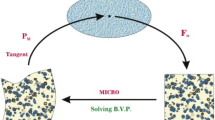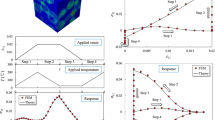The aim of this paper is to evaluate the effective material properties of particle-reinforced composites. The Mori–Tanaka approach overstates the strain of inclusions and therefore underestimates the resulting effective rigidity of composite materials. We propose an iteration method for the Mori–Tanaka approach. Initially, the effective elastic tensor of a composite material is found by using the Mori–Tanaka approach. Then the new composite is taken as a background material, and the inclusions and matrix are both embedded into it. The resulting material is softer than predicted by the self-consistent approach, but stiffer than forecasted by the Mori–Tanaka method. The predictions are compared with data from the literature and are shown to be very accurate over wide ranges of inclusion concentration.



Similar content being viewed by others
References
W. Voigt, “Uber die Beziehung zwischen den beiden Elastizitätskonstanten isotroper Korper.Wied Ann, 38, 573–587 (1889).
A. Reuss, “Berechnung der fliessgrenze von Mischkristallen auf Grund der Plastiztatasvedingung für Einkristalle,” Z angew Math. Mech., 9, 49–58 (1929).
R. Hill, “A self-consistent mechanics of composite materials,” J. Mech. Phys. Solids, 13, 213–222 (1965).
A. V. Hershey, “The elasticity of an isotropic aggregate of anisotropic cubic crystals,” J. Appl. Mech., 21, 226–240 (1954).
E. Kröner, “Berechung der elastischen konstanten des vielkristallsaus den konstanten des Einkristalls,” Z. Phys., 151, 504–518 (1958).
B. Budiansky, On the elastic moduli of some heterogeneous materials,” J. Mech. Phys. Solids, 13, 223–227 (1965).
R. Hill, “A self-consistent mechanics of composite materials,” J. Mech. Phys. Solids, 13, 213–222 (1965).
S. Nemat-Nasser and M. Hori, Micromechanics: Overall Properties of Heterogeneous Materials. Elsevier, North–Holland, 1993.
M. Hori and S. Nemat-Nasser, “Double-inclusion model and overall moduli of multi-phase composites,” Mech. Mater., 14, 189–206 (1993).
T. Mori, and K. Tanaka, “Average stress in matrix and average elastic energy of materials with misfitting inclusions,” Acta Metall. Mater., 21, 571–574 (1973).
R. M. Christensen and K. H. Lo, “Solutions for effective shear properties in three phase space and cylinder model,” J. Mech. Phys. Solids, 27, 315–330 (1979).
Y. Huang, K. X. Hu, and A. Chandra, “A generalized self-consistent mechanics method for microcracked solids,” J. Mech. Phys. Solids, 42, 1273–1291 (1994).
G .K. Hu and G. J. Weng, “Some reflections on the Mori–Tanaka and Ponte Castaneda–Willis methods with randomly oriented ellipsoidal inclusions,” Acta Mech., 140, 31–40 (2000).
14 A. A. Pan’kov, “Generalized self-consistent method: Modeling and computation of effective elastic properties of composites with composite or hollow inclusions,” Mech. Compos. Mater., 34, 123–131 (1998).
A. A. Pan’kov, “Generalized self-consistent method for predicting the effective elastic properties of composites with random hybrid structures,” Mech. Compos. Mater., 33, 201–202 (1997).
G. J. Weng, “Some elastic properties of reinforced solids, with special reference to isotropic one containing spherical inclusions,” Int. J. Eng. Sci., 22 No. 7, 845–856 (1984).
17 L. X. Li and T. J. Wang, “A unified approach to predict overall properties of composite materials,” Mater. Charact., 54, 49–62 (2005).
J. D. Eshelby, “The determination of the elastic field of an ellipsoidal inclusion and related Problem,” Proc. R. Soc. Lond. A, 241, 376–396 (1957).
X. Peng , N. Hu, H. Zheng , and H. Fukunaga, “Evaluation of mechanical properties of particulate composites with a combined self-consistent and Mori–Tanaka approach,” Mech. Mater., 41, 1288–1297 (2009).
J. W. Ju and T. M. Chen, Princeton, New Jersey. Effective elastic moduli of two-phase composites containing randomly dispersed spherical inhomogeneities,” Acta Mechanica, 103, 123–144 (1994).
M. Kouzeli and D. C. Dunand, “Effect of reinforcement connectivity on the elasto-plastic behavior of aluminum composites containing submicron alumina particles,” Acta Mater., 51, 6105–6121 (2003).
L. J. Cohen, O. Ishai, “The elastic properties of three-phase composites,” J. Compos. Mater., 1, 390–403 (1967).
T. G. Richard, The mechanical behavior of a solid microsphere filled composite,” J. Cmp. Mater. 9, 108–113 (1975).
J. C. Smith, “Experimental values for the elastic constants of a particulate-filled glassy polymer,” J. Res. NBS 80A, 45–49 (1976).
J. B. Walsh, W. E. Brace, and A. W. England, “Effect of porosity on compressibility of glass,” J. Am. Ceram. Soc. 48, 605–608 (1965).
Acknowledgements
The authors gratefully acknowledge the financial support to this work from NSFC under Grant Number 10976032. We are also grateful to X. Peng and H. Zheng for the support and theoretical help.
Author information
Authors and Affiliations
Corresponding author
Additional information
Russian translation published in Mekhanika Kompozitnykh Materialov, Vol. 49, No. 3, pp. 445-454, May-June, 2013.
Rights and permissions
About this article
Cite this article
Fang, C., Xie, X. An iterative Mori–Tanaka approach. Mech Compos Mater 49, 305–310 (2013). https://doi.org/10.1007/s11029-013-9347-1
Received:
Published:
Issue Date:
DOI: https://doi.org/10.1007/s11029-013-9347-1




